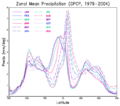Tropic facts for kids
A tropic is a word that can mean a few different things, but it's most often used in geography. It usually refers to special lines on a map or the warm, sunny areas of the world found near the Earth's middle. These areas are known for their hot weather and amazing plant and animal life.
Contents
What Are the Tropics?
When people talk about "the tropics," they usually mean the parts of the Earth that are warm all year round. These regions are located around the equator, which is an imaginary line that circles the Earth's middle. The tropics are found between two other important imaginary lines: the Tropic of Cancer and the Tropic of Capricorn.
Tropic of Cancer
The Tropic of Cancer is a special line of latitude located in the Northern Hemisphere. It's about 23.5 degrees north of the equator. On the longest day of the year in the Northern Hemisphere, around June 21st, the Sun's rays shine directly overhead at noon along this line. This day is called the summer solstice.
Tropic of Capricorn
The Tropic of Capricorn is the matching line in the Southern Hemisphere. It's about 23.5 degrees south of the equator. On the longest day of the year in the Southern Hemisphere, around December 21st, the Sun's rays shine directly overhead at noon along this line. This day is called the winter solstice in the Northern Hemisphere, but it's summer in the Southern Hemisphere!
Why Are the Tropics Warm?
The areas between the Tropic of Cancer and the Tropic of Capricorn are warm because they receive a lot of direct sunlight throughout the year. The Sun's rays hit these parts of the Earth more directly than they do at higher latitudes (areas closer to the North or South Poles). This direct sunlight means more heat and less change in temperature between seasons.
Life in the Tropical Zones
Because of the warm temperatures and often plenty of rain, tropical regions are home to an incredible variety of plants and animals.
- Tropical Forests: Many tropical areas have rainforests, which are dense forests with tall trees and many layers of plant life. These forests are bursting with biodiversity, meaning they have a huge number of different species.
- Tropical Animals: You can find amazing creatures like colorful birds, monkeys, jaguars, and many types of insects and reptiles in tropical regions.
- Tropical Plants: Common plants include palm trees, orchids, and many fruits like bananas and pineapples.
Other Uses of the Word Tropic
Sometimes, the word "Tropic" is used in other ways, but these are less common than its geographical meaning. For example, "Tropic" can be the name of a town, like Tropic, Florida, or Tropic, Utah, in the United States. It has also been the name of ships, like the SS Tropic.
Images for kids
See also
 In Spanish: Zona intertropical para niños
In Spanish: Zona intertropical para niños





